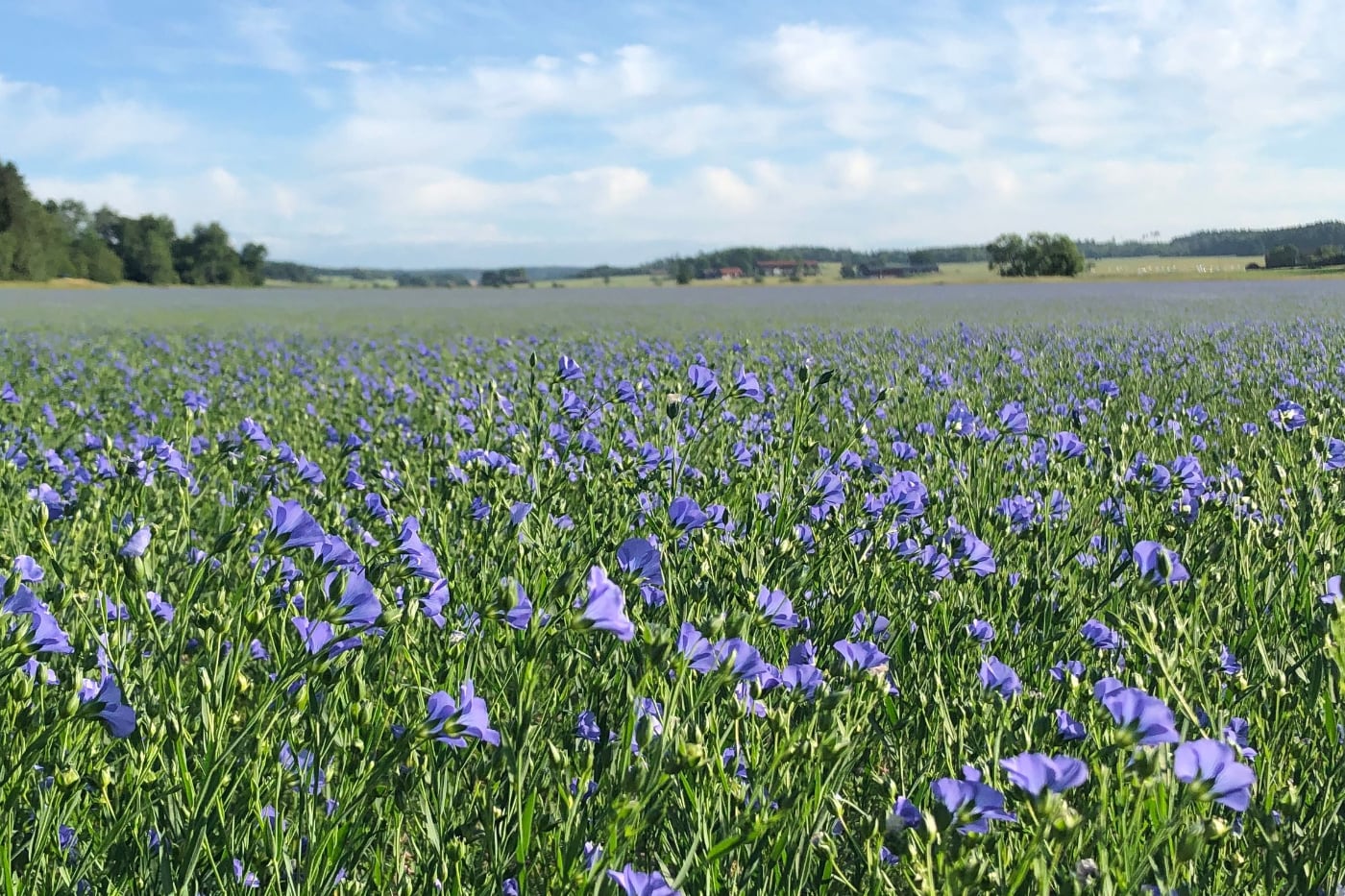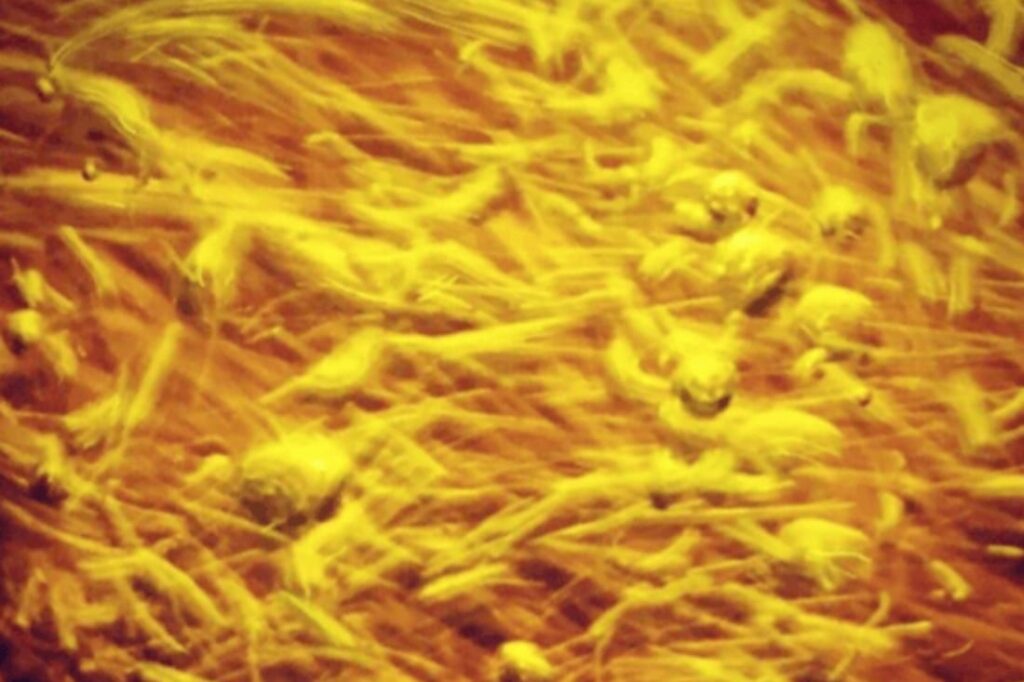
Technology
Read more about the technology behind Selder & Company’s high-quality linseed oil
Refinement of linseed oil
We refine linseed oil using modern production methods that we have developed on the basis of classic refining technology. Watch the video below where Mikkel tells more about Selder’s linseed oil.
Summary
Linseed oil is a mixture of fatty acids, proteins, waxes and antioxidants. Of these, only the unsaturated fatty acids have the properties necessary for linseed oil paints and impregnation oils. All other ingredients in the linseed oil impair the end result.
Unsaturated fatty acids oxidize with the oxygen of the air into molecular chains. These form an elastic polymer called linoxin. It is water-repellent and resists fats, petroleum products, salts and household acids, e.g. lemon, wine and vinegar. No living organism can assimilate linoxin, so it is indefinitely sustainable. We remove the linseed oil’s other constituents through refining and save the unsaturated fatty acids. We cook them in different ways into oil products with optimal viscosity and curing time for intended use, i.e. impregnation of wood, polishing of wood, rust protection and protection of porous stone.
Linseed oil was similarly refined for the best linseed colors and linseed oils until the middle of the 20th century. The process was extremely time-consuming and labor-intensive, and fell into oblivion after the synthetic colors became popular.
The chemistry behind drying linseed oils
Linseed oil contains two drying fatty acids: linoleic acid, whose molecules contain two double bonds between oxygen atoms, and linolenic acid, which contains three. These can form essentially unlimited long molecular chains, i.e. polymerized, by oxidation.
An oxygen atom in e.g. the air forms a bridge between the double oxygen bonds in two molecules of unsaturated fatty acids by binding to the single oxygen bond in each molecule. Thereby, fatty acid molecules are combined into a larger molecule. Since linoleic acid can form bridges to two other fatty acid molecules, and linolenic acid to three, the polymerization can continue until giant molecules have been formed. The end result is an elastic polymer called linoxin.
Linseed oil also contains oleic acid, whose molecules contain a double bond between oxygen atoms. Linseed oil also contains oleic acid, whose molecules contain a double bond between oxygen atoms.
All other components of the linseed oil contribute to the drying, color fastness, durability and mold resistance of oils and paints.
Harmful ingredients for linseed oil paints and impregnation and polishing oils
Antioxidantsstrong
, tendency of linoleic and linolenic acid to polymerize with oxygen is a threat to seed germination. Therefore, antioxidants are formed in the linseed, mainly tocopherol, i.e. Vitamin E.
If the antioxidants are not removed, the linseed oil paint takes a week or more to dry, often incompletely. This can be remedied by adding a desiccant, siccative, usually cobalt zirconium carboxylate. However, this gives the oil a tendency to not dry through but only on the surface; to skin dry. To prevent this from happening, 2-butanone oxime is also often added.
The success of these chemical additives is variable. The presence of antioxidants is the reason why you can read in manuals for linseed oil paint that you should paint very thin layers, that you should not paint in sunlight and only during the warm season, and that linseed oil paint dries much more slowly than alkyd paint (read more about this below ).
Selder & Company has solved the problem by removing the antioxidants.
Beta carotene
Flaxseed oil contains beta-carotene, an antioxidant that turns yellow over time. This permanent yellowing should not be confused with the linseed oil being photochromic, i.e. turns yellow in the dark and fades in a few hours when exposed to light.
Selder & Company has solved the problem of permanent yellowing by removing the beta-carotene.
Saturated fatty acids
Linseed oil contains two saturated fatty acids: stearic and palmitic acid. These cannot dry, as they do not contain double bonds between oxygen atoms. Instead, they go rancid, react with water and provide food for microorganisms. Manufacturers of linseed oil paint therefore often add fungicides.
In addition, stearic and palmitic acids break down quite quickly, which causes the binder in the paint to disappear, leaving only the pigment grains, thereby changing its light refraction – the paint “chalks”. You can read in manuals for linseed oil paint that it must be refreshed every few years.
When oil, varnish or paint containing these fatty acids is exposed to moisture, white spots of oil/water emulsion appear on the surface, which can be wiped off with the finger or a cloth.
Selder & Company has solved the problem by removing these fatty acids.
Waxing
Waxes on the seed coat form a sticky gel with water. Therefore, linseed sticks to passing animals and can spread. When oil, varnish or paint containing such waxes is exposed to moisture, white spots of gel appear on the surface which can be wiped off with the finger or a cloth.
Selder & Company has solved the problem by removing the waxes.
Proteins
Proteins are excellent nutrients for all organisms and are easily broken down. De är den viktigaste ingrediensen i linoljans biologiska sönderfall.
Selder & Company has solved the problem by removing the proteins.
Alkyd oil paint is polyester, a plastic
Wikipedia/ Encyclopædia Britannica: “Alkyd, or alkyd resin, is the binder in alkyd paint. It is a type of synthetic resin produced by polymerizing an alcohol, often glycerol, and an organic acid, for example phthalic acid, through esterification, into a polyester, which in turn is provided with unsaturated fatty acids from, for example, linseed oil.”
National Antiquities Authority, Material guide on alkyds: “Linseed, soy and pine oil are the most common starting products, but fish oil, Chinese wood oil, safflower oil, as well as non-drying oils such as coconut and castor oil and synthetic fatty acids also occur.”
National Antiquities Authority, Material guide: “During a period, alkyd oil paints were also used in restorations as a substitute for linseed oil paint. But despite shorter drying times and better impact resistance [our note: compared to linseed oil paint made with unrefined linseed oil] the alkyd paints had difficulty meeting the requirements of good penetration, elasticity and an authentic appearance during aging and degradation.”
Selder & Company linseed oil paints are genuine oil paints.
Process technology
By applying modern process technology to the ancient art of refining linseed oil, we can rationally produce pure polyunsaturated oils. Pumpar, tankar, rör och processkärl är så långt det är möjligt tillverkade av rostfritt eller syrafast stål. This allows us to maintain the production hygiene required to produce products of high and consistent quality. The raw materials are supplied to the process via PLC-controlled weighing equipment and automatic valves. Therefore, they are added in exactly the right amounts at the right time and the end products always get the right properties.
Use
The refined linseed oil is used as a binder in Selder & Co’s linseed oil paints and as a water-repellent impregnating agent and polishing agent for wood, porous stone and as corrosion protection for metal. Read more under LINSEEDOIL PAINT, PRIMER OIL, FLOOR OIL, FURNITURE OIL, LINSEED OIL VARNISH, STONE OIL, RUSTPROOFING OIL.
From the non-drying fatty acids that we separate during refining, we make FLOOR SOFT SOAP or STRONG SOFT SOAP.
The other residual products go to biogas production.

Do you want us to call you?
